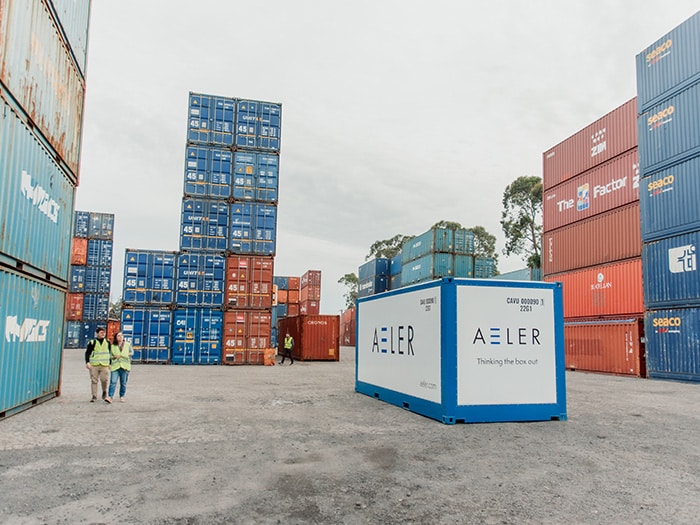
Op-Ed: Increasing payload with sustainable container technology
Written by
By increasing payload capacity, companies can transport more goods with fewer containers, reducing shipments and decreasing shipping costs, writes Baur.
By David Baur, Co-CEO and co-founder, AELER
The maritime shipping industry is currently navigating turbulent waters due to escalating tensions in the Red Sea. This situation has led major shipping companies to halt operations through this vital corridor, and the subsequent rerouting of ships around the Cape of Good Hope has significantly increased travel distance and time, leading to a substantial rise in shipping rates and a strain on global supply chains.
Data from Xeneta reveals a drastic increase in shipping costs: rates for 40-foot containers from Asia to Europe have surged to an average of $4,765, a significant jump from $1,415 in early December. This escalation is not only due to longer sailing times and higher fuel costs but also increased insurance premiums and surcharges.

This crisis is particularly acute for the bulk liquid market, as the route from the Far East to Europe and the U.S. is a crucial transport pathway for the movement of essential commodities such as edible oils, chemicals, industrial liquids and beverages.
This combination of factors and continuous strains on the supply chain indicate that the crisis will likely have enduring effects. For example, industry forecasts by European logistics experts suggest a potential surge in the rates for a forty-foot equivalent unit (FEU) to as much as $12,000 by February 2024, reflecting a tightening market with increasingly limited availability of shipping space.
The Crucial Role of Increased Payload
This crisis, combined with the still recent effects of COVID-19, such as the disruption of the supply chain and the dependence of certain importing countries on exporting countries, accentuates the vulnerability of logistics and international trade to disruptions. Moreover, macroeconomic headwinds have created a highly restrictive environment for logistics operations, which have become more expensive.
Considering current challenges, the maritime shipping industry must do more than simply adopt short-term solutions such as route changes, which result in longer delivery schedules and heightened shipping rates. Instead, it should look beyond more long-term strategies and shift to smarter, sustainable technologies that will enhance its cost competitiveness.
One such innovation is the introduction of smart containers in transportation, marking a significant shift from the more than 60-year-old steel containers that have been foundational for modern trade. While acknowledging the historical significance of steel containers, it’s crucial to recognize their limitations in terms of space utilization, tracking capabilities, and sustainability standards. These containers often required adaptations such as additional insulation, highlighting the need for a new approach where containers adapt to cargo owners’ requirements.
In contrast, newer models of shipping containers are designed to be foldable or more robust, enhancing their efficiency. This design enables them to carry more payload or occupy less space when transported empty, thus reducing the cost per ton.
By increasing payload capacity, companies can transport more goods with fewer containers, directly reducing the number of shipments required and decreasing total shipping costs. For example, with actual ocean rates continuing to rise, they could easily hit $5,000 from Asia to Europe shortly. In this case, bulk liquid shipments would likely cost up to $7,000 due to trucking and flexibag costs. In this scenario, increasing payload by 17% would reduce the cost per ton to transport from $292/ton to $275/ton. At scale, such cost savings from an increased payload of ships stacked with such containers could help offset the cost spikes from any disruptive shipping event.
Resilient Shipping in Times of Crisis: Embracing New Technologies
As the maritime shipping industry navigates the challenges presented by rising costs and global disruptions, such as the crisis in the Red Sea, it’s clear that adopting smarter, strategic approaches is crucial. This situation underscores the importance of incorporating new tools and strategies to ensure flexibility and resilience in future uncertainties, safeguarding global supply chains.
Industry stakeholders must prioritize a high-level analysis of key elements that enhance operational resilience. This includes exploring advanced technologies for cargo efficiency, optimizing route planning, and adopting sustainable practices. This approach would ensure agility, allowing the industry to adapt to innovations and maintain robust operations in a volatile global market.
About the Author
David Baur is the co-CEO and co-founder at AELER, a smart-container-as-a-service shipping and logistics startup. In this role, he is responsible for managing AELER’s business strategy and operations, with a remit to ensure the long-term success of the Unit One container. Baur is an active proponent of the company’s innovation pipeline and an active champion of the company’s external customer engagement affairs across different geographies.
Before co-founding AELER in 2018, Baur worked in quality control at the Swiss luxury watch company Jaeger-LeCoultre, in which capacity he was instrumental in successfully reshaping its Swiss facility’s quality assurance and logistics processes.
Baur is a trained engineer. He holds both a master’s degree and bachelor’s degree in microengineering from the Swiss Federal Institute of Technology, one of the world’s best engineering schools.




